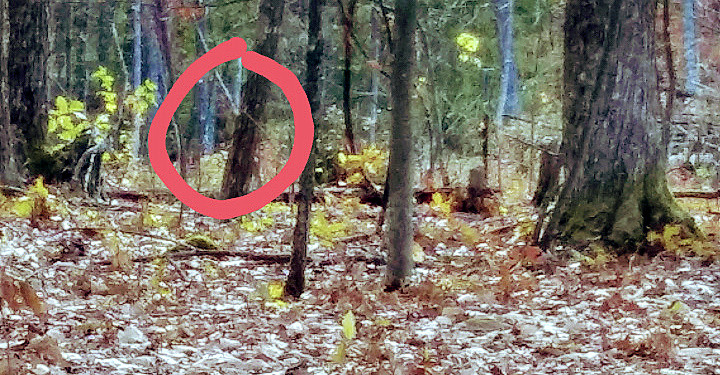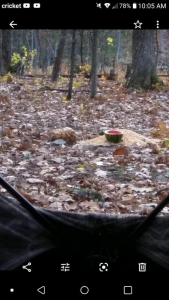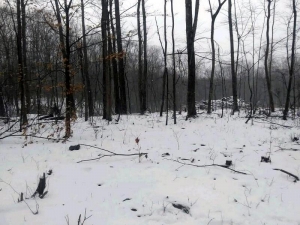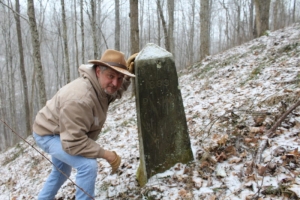
A husband and wife living in a remote corner of Fayette County in southern West Virginia claim to have encountered and photographed a bigfoot only a stone's throw from America's newest national park, the New River Gorge National Park and Preserve.
Billy Humphrey, of Danese, says that before the incident he had ridiculed such claims but has spent the last half-year turning the encounter over in his mind.

"I didn't believe in bigfoot," Humphrey says. "I one-hundred-percent didn't believe in it, and I said that people who claimed they saw it were crazy."
According to Humphrey—a hunter, coal miner, and former U.S. Marine—the encounters first occurred in late October 2019 in the woods near his home where he'd set up a hunting blind.
On a series of consecutive nights, food that he'd put out to attract game had been disappearing more quickly than was usual. "Everything was gone within hours—all of it," he said.
So he spent part of the next two nights in a deer-blind hoping to catch the culprits and perhaps some game. He set up a cam and hung a light pointed downward from about nine feet off the ground to help spot whatever had been taking the food. Then he waited.
"I knew I had some raccoons, and we've got deer and bear, but whatever it was, it was eating everything, and I was determined to find out what was going on."
Far from city lights, night in the woods in West Virginia can grow scary, unsettling at least, but even then, something wasn't right, he said.
He texted his wife, Sheena: "Something is eerie up here. There ain't nothing moving."
Then whatever had been taking the food stalked up through the wooded darkness from the left until it stood just outside the blind. Then it moved behind the blind. Humphrey waited, breathless.
"There's something heavy moving behind the blind,' I texted her. It stood there for, oh, about a minute, then it came around to the right side, then moved in front, passing in front of the light.
"I thought it was a bear because it was tall enough that it cast a shadow when it passed in front of the light, but the light was nine feet up, so whatever it was, it was big."
Only able to see its silhouette in the darkness, Humphrey didn't seriously question that it was anything other than a large bear, though it was remarkably large and the forest had grown remarkably quiet.

The same encounter occurred the next night, after which the food that he had stored in the blind had been exhausted, so he returned for a third evening at about 4 p.m., this time with Sheena, who had gotten off work early.
"I said, 'Let's just wait here till dark and see what happens.' Well, we'd only been sitting there for about 15 minutes when it came back. We looked out, and Sheena says, calmly, 'There he is.' I said, 'There who is?' Bigfoot,' she said.
Billy Humphrey says he was able to snap a quick photo with his phone but did not have a better camera handy.
"Then he just turned and walked off. We heard him go through the laurel thicket, and then he made this sound like—have you ever heard a bear's death moan? He went, like, "Whoooooooah!"
As brave and wood-hearty as Humphrey may be, he says he declined to return to the blind for another month, and when he did, he found it shredded. "But not like a bear would tear it apart— looking for food."
Read also: Bigfoot sightings at Sutton Lake have historic precedence
After that, other signs of a bigfoot began to reveal themselves. Fowl had been disappearing from the family's farm—chickens as well as turkeys, Sheena Humphrey pointed out.
"I had 104 chickens, and then we realized we had 60," she said, "but there was no sign of them being killed—no blood or feathers."
Sheena had encountered a bigfoot on two earlier occasions and had once heard her grandmother telling such tales. So she was much less shocked than her husband was when they had their autumn encounter.
"The first time I saw one I was about 16 or 17 and riding in a car with my mother past Babcock State Park, and I looked to my left, and he was just standing there in the woods, plain as day," she said.
"I was so persistent about going back that she turned around, but by then it was gone. But I got a good look because we were only going 35 through a curve and it was spring, and there weren't many leaves on the trees.
"The next time I saw one I was driving down Layland Mountain near Bowyer Mine Supply right before you get to the bridge that washed out a few years back. I might have been 29 or 30.
"It was standing there, and I thought it was a bear at first, but there were two motorcycles in front of me, and I guess they scared it because as soon as the first motorcycle passed, it stood up and cleared that creek and ran up the side of the mountain."
She says she assumes there could be several bigfoots in the area at times as their fur had been colored differently. "The first was darker—reddish brown— and this other a little darker than a deer in winter."
Until recently, the couple spoke to no one about the encounter, then Billy heard of a friend who had claimed that a wild man of some sort had been found living in a cave near Chestnut Knob, several miles to the west, and a farmer on Backus Mountain, several miles to the south, had said that something had been spooking her cattle.
Could a bigfoot or a group of apelike hominids live undiscovered in the region? The area is part of a vast woodland that spans more than 800 square miles, bounded on the south and west by the New River Gorge National Park and Preserve and the northeast by the Monongahela National Forest.
There could be room enough between the two federally managed forest areas for such beasts to roam. "There's a lot of lands owned by hunting clubs in here where people don't go eight months out of the year," Sheena Humprey says.
Billy Humphrey says he'll never forget the look of the creature. "It was massive, and about eight-and-a-half feet, I guess. Sheena went and stood where he'd been standing, and she's about five-seven. In the picture, he's actually standing so his lower half is over the hillside.
The thing was huge. It had a cone head, and it was tan under the eyes and had a barrel chest. The original photo of bigfoot you see in the Patterson–Gimlin film—that's what it looked like. It didn't look like some of the other photos you see," Humphrey said.
Humphrey says he's now a believer and will invite anyone who would like to come to see the clearing near his home and inspect the area. "I hate it because I've made fun of people like that—who had claimed to see these things."
Sign up to receive a FREE copy of West Virginia Explorer Magazine in your email weekly. Sign me up!
Storied West Virginia monument stands forgotten in woods

Finding it on a map is difficult. Finding it in the woods is even harder. But on a remote hillside at the southeast corner of Marshall County stands a weathered monument that establishes West Virginia's singular northern panhandle. Some say it's a site that every panhandle resident should see. Some say it's a site that every West Virginian should see and that it should be declared a park. Read the full story here.





























